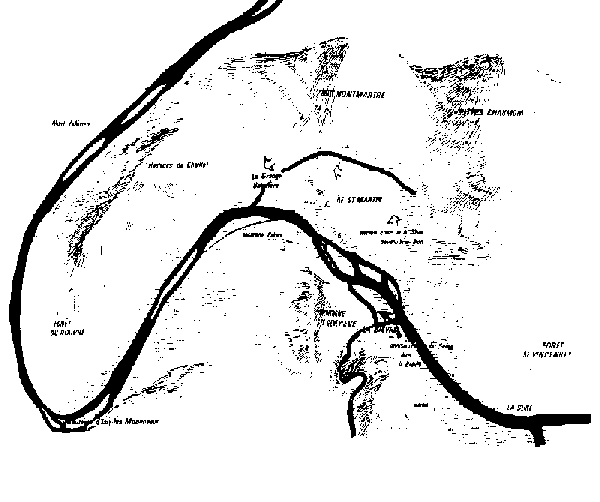
The Story of Paris
This does not claim to be an exhaustive History of the world's most beautiful city. It is not a political history, or a military history, or a social history. It is simply the story of how and when the actual buildings of Paris came to be where they are. Paris is neither a planned city nor an unplanned one; it is a place that just happened, very carefully. It is the capital city of a people who have always been passionate about the Arts; and architecture is the most public of the Arts. Inevitably, ninety percent of everything has been left out. If your favourite building isn't mentioned, nor are most of mine. Special attention has been paid to the development of four important elements; the ever-expanding series of walls, the ever-growing Louvre, the changing fortunes of the district called the Marais, and the centre of it all, the Île de la Cité.
1: Roman
Paris
Many towns start on hills because they are fortresses, the homes of warlike aristocrats round whom the common folk huddle for protection. But Paris was from the start commercial, a trading town whose ways were essentially opposed to the aristocratic principle. For traders, the site was ideal; a comparatively easy crossing-point on the great river that was the principal highway of the region, on an easily defensible island midway between the confluences of the Oise and the Marne.
To the North, a former branch of the Seine had left a marsh, with a sort of natural causeway across it about where the Boulevard de Sebastopol is now, leading to the hills of Montmartre, Ménilmontant and the Buttes Chaumont. To the South, more hills, now the Montagne Sainte-Geneviève, the Buttes aux Cailles and Montparnasse. Two streams entered the Seine among the numerous little islands; the Bièvre in the South, and in the North the Grange Batelière, which still runs in a tunnel below the Opéra, factual home of the imaginary Phantom.
The Parisii arrived with the great Gaulish invasions of 300 BC, and soon built a flourishing town with two wooden bridges whose sites are now marked by the Pont Notre Dame and the Petit Pont. By the time the Romans came, Lutetia (the name means marshy was big enough to send an army of 8,000 men to help Vercingetorix against Julius Caesar. Unfortunately, Caesar simultaneously sent Labienus to capture Lutetia, which the absence of its warriors rendered comparatively painless. The inhabitants, however, burnt the place down rather than surrender it to the Romans.
That was in 52 BC. Over the next 300 years Lutetia developed into
a city of some importance.  Reserving the Island for administration and
religion, the romanised Parisii spread onto the Left Bank to the
South of the river. The Right Bank at this stage was mostly marsh.
Not much of Roman Paris can still be seen. The baths at the
Musée de Cluny are impressive, especially when you consider
that these were only the second-largest baths in Lutetia. There is an
archaeological crypt under the Place du Parvis in front of
Notre-Dame, showing some of the remains found on the Ile de la
Cité. Most striking of all, however, is the Arena, Les
Arènes de Lutèce, just off the Rue Monge. This was a
dual-purpose amphitheatre, of a particularly Gallic type. The
audience could sit on the tiered benches around the rim to watch
gladiatorial or wild-beast shows, or on the sand itself to watch
spectacles performed in front of the sound-wall at one side of the
arena.
Reserving the Island for administration and
religion, the romanised Parisii spread onto the Left Bank to the
South of the river. The Right Bank at this stage was mostly marsh.
Not much of Roman Paris can still be seen. The baths at the
Musée de Cluny are impressive, especially when you consider
that these were only the second-largest baths in Lutetia. There is an
archaeological crypt under the Place du Parvis in front of
Notre-Dame, showing some of the remains found on the Ile de la
Cité. Most striking of all, however, is the Arena, Les
Arènes de Lutèce, just off the Rue Monge. This was a
dual-purpose amphitheatre, of a particularly Gallic type. The
audience could sit on the tiered benches around the rim to watch
gladiatorial or wild-beast shows, or on the sand itself to watch
spectacles performed in front of the sound-wall at one side of the
arena.
Oddly enough, the Roman Port of Paris has never been discovered, though records show that the most important people in the City were the Nautes, the river sailors. The prosperity they brought, controlling as they did the traffic of the most important artery of Northern Gaul, gave Lutetia Parisiorum three hundred years of prosperity, before it had to brace itself once again before the tide of history.
The early history of Europe is a tale of successive invasions from the East. The Romans themselves were part of the process, and the Barbarians who reached Lutetia in 253 were the beginning of the end for the Roman Empire. The people of Lutetia retreated to the Island and watched helplessly as the town was destroyed even to the amphitheatre, which was filled and became a graveyard. When the Barbarians had gone, the authorities, needing scapegoats for the national defeat, turned on the Christians. The then Bishop of Paris, Denis, together with his deacons Rusticus and Eleutherius, was beheaded on the slopes of Montmartre, which takes its name either from this event (Mons martyrium, the Mount of Martyrs), or from the Temple of Mercury on its summit (Mons Mercurii). According to legend, Denis then picked up his head and left town, finally expiring at the feet of a holy lady who buried the three martyrs in a village now known as Saint-Denis, the burial-place of French Kings forever afterwards.
Lutetia continued to be a place of some importance in the increasingly rickety Roman Empire; the Emperor Julian was proclaimed here in 357, and Valentinian paid a visit in 375; but by the Fifth Century the Romans were a memory, the town was reduced to the island, and its name was no longer Lutetia, but simply Paris. In the sixth century, punctual to their three-hundred-year cycle, the Barbarians came again, in two waves, the Huns followed by the Franks.
The Huns, led by the appalling Attila, were strangely enough no problem. The prayers of a peasant-girl were enough to save Paris: Genevieve, born in 511 and working miracles by the age of twelve, asked for the Huns to turn aside, and they turned aside. Paris marks their furthest point West. The Franks (as the name of the country testifies) were a different matter. Genevieve managed to obtain supplies for the siege, but in the end had to be satisfied with an indirect triumph. She converted to Christianity a noble Frankish lady called Clothilde, who then married their King, Clovis, who was also converted. Clovis became the first King of France, crowned at Rheims like all the others after him, and Genevieve is now the patron Saint of Paris. The town itself took over from Soissons as the Frankish capital.
Because the Frankish kingdoms were mainly to the North, the towns expansion on this occasion was on both banks of the river. King Childebert I built a Cathedral on the island, roughly where Notre-Dame is today; and the other end of the island, where the Roman praetorium had been, became the royal palace. The abbey of Sainte-Croix-Saint-Vincent was founded, which changed its name not long afterwards to Saint-Germain-des Prés, the oldest church in Paris though the actual fabric of Saint-Julien-le-Pauvre (opposite Notre-Dame on the Left Bank) is probably older.
The kingdom of the Franks was never enormously stable, and was positively falling to bits when it was rescued by a succession of strong men. Charles Martel (the hammer) took over the throne after defeating the Moors at Poitiers in 732 and throwing them out of France. He left the French section of his Kingdom to his son Pépin le Bref (the short), who was the father of one of the great men of European history: Charlemagne.
Starting from his base as King of the Franks, Charlemagne gradually conquered Aquitaine, Italy and Germany, and was crowned Holy Roman Emperor on Christmas Day in the year 800 the simplest of all dates to remember. His capital, however, was at Aix-la-Chapelle (Aachen, in Germany), and Paris suffered a temporary eclipse.
 After Charlemagne, the Franks were ruled by a succession of dim
and unexciting Kings notable only for their names Louis the Pious,
Charles the Bald, Louis the Stammerer, Charles the Simple. (Later in history
France was to see Louis the Foreigner, the Idler, the Fat, the Young, the Lion
and the Quarrelsome.) By the end of the Ninth Century it was time for another
invasion. For a change, this came from the West. The Normans, men from the North
we would call them Vikings pillaged Paris in 845. The inhabitants set to work
and rebuilt the Roman wall around the Ile de la Cité, and were ready for the
Normans return in 885. A years siege was only ended when King Charles le Gros
(the fat) paid a ransom of 700 livres. During the siege the suburbs were
entirely destroyed, and Paris entered the Middle Ages once more reduced to the
size of the island.
After Charlemagne, the Franks were ruled by a succession of dim
and unexciting Kings notable only for their names Louis the Pious,
Charles the Bald, Louis the Stammerer, Charles the Simple. (Later in history
France was to see Louis the Foreigner, the Idler, the Fat, the Young, the Lion
and the Quarrelsome.) By the end of the Ninth Century it was time for another
invasion. For a change, this came from the West. The Normans, men from the North
we would call them Vikings pillaged Paris in 845. The inhabitants set to work
and rebuilt the Roman wall around the Ile de la Cité, and were ready for the
Normans return in 885. A years siege was only ended when King Charles le Gros
(the fat) paid a ransom of 700 livres. During the siege the suburbs were
entirely destroyed, and Paris entered the Middle Ages once more reduced to the
size of the island.
Outside the walls there remained a Temple of Isis to the South-West, where Saint-Germain-des-Prés now stands. There was also a Temple of Mercury on the hill at Montmartre to the North, and probably a Temple of Mithras on the island.
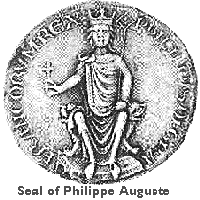
2: Medieval Paris
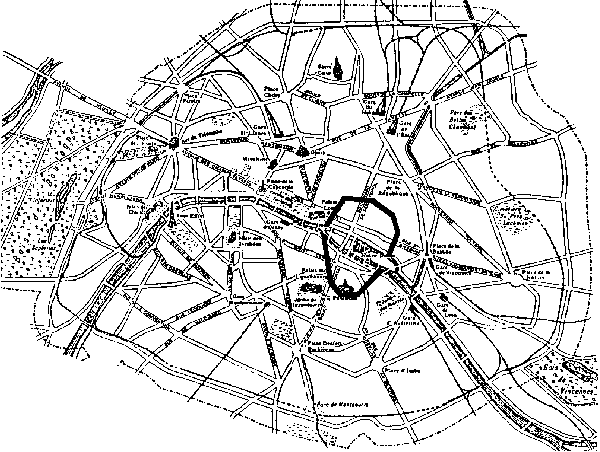 In 910 the Normans under Rollo carved out a Duchy for themselves
in the North-West; by 1050 they were again a threat to France, and
this time the Seine valley was of strategic importance. Philippe I
moved back to Paris, which grew steadily over the next century. In
1172 the population had reached a level at which a new cathedral was
considered necessary. Bishop Maurice de Sully laid the foundation
stone of Notre-Dame, and building went on until 1340. By the
accession of Philippe-Auguste in 1180, the city was established as
the capital of France. Philippe-Auguste built the first defences on
the mainland, enclosing Paris, both Left and Right Banks, in a ring
of walls with thirty towers and twelve gates. The
weakest point of the wall was where it met the river in the West, at
a point too wide to bridge. Here a great fortress went up, the Louvre
(the name probably comes from louverie, a wolfs lair.) This was not,
at this stage, a royal palace; the Kings still lived on the island,
in the Palais de la Cité. On the Île de la Cité
itself, the Palace was used as a treasure-house and an arsenal. From
its South-Eastern tower a chain barrier was hung across the river to
the Tour de Nesle on the Left Bank.
In 910 the Normans under Rollo carved out a Duchy for themselves
in the North-West; by 1050 they were again a threat to France, and
this time the Seine valley was of strategic importance. Philippe I
moved back to Paris, which grew steadily over the next century. In
1172 the population had reached a level at which a new cathedral was
considered necessary. Bishop Maurice de Sully laid the foundation
stone of Notre-Dame, and building went on until 1340. By the
accession of Philippe-Auguste in 1180, the city was established as
the capital of France. Philippe-Auguste built the first defences on
the mainland, enclosing Paris, both Left and Right Banks, in a ring
of walls with thirty towers and twelve gates. The
weakest point of the wall was where it met the river in the West, at
a point too wide to bridge. Here a great fortress went up, the Louvre
(the name probably comes from louverie, a wolfs lair.) This was not,
at this stage, a royal palace; the Kings still lived on the island,
in the Palais de la Cité. On the Île de la Cité
itself, the Palace was used as a treasure-house and an arsenal. From
its South-Eastern tower a chain barrier was hung across the river to
the Tour de Nesle on the Left Bank.
With greater protection, more people were keen to live in the city, and population growth was immediate and explosive. On the Right Bank, building began on the marshy Eastern area, known to this day as Le Marais. On the Left Bank, the University was founded in 1215 essentially a School of Theology, where all debate and discussion was in Latin. The Petit Pont, joining the Left Bank to the island, was rebuilt in stone, and on the Right Bank the cemetery of the Holy Innocents was enlarged. This was the only cemetery in Paris for six hundred years; bones from re-used graves were stacked in a series of charnel-houses around the perimeter.
At the same time as work went on on Notre-Dame, the church of Saint-Julien-le-Pauvre (nowadays the Greek Orthodox church of Paris), on the Left Bank opposite the Cathedral, was almost completely rebuilt.
Philippe-Auguste took part in the First Crusade; his grandson, Louis IX, led the second and was later canonised as Saint-Louis. From his reign (1214-70) Paris retains a number of monuments. In the course of his crusading, Louis had come into possession of a number of valuable relics, including some fragments of the true cross and the Crown of Thorns. To house these he built, in the heart of the Palais de la Cité, the Sainte-Chapelle, a Gothic masterpiece designed by Pierre de Montreuil, a perfect example of medieval engineering, whose aim was to produce walls with as little stone and as much glass as possible. Much of the glass survives to this day.
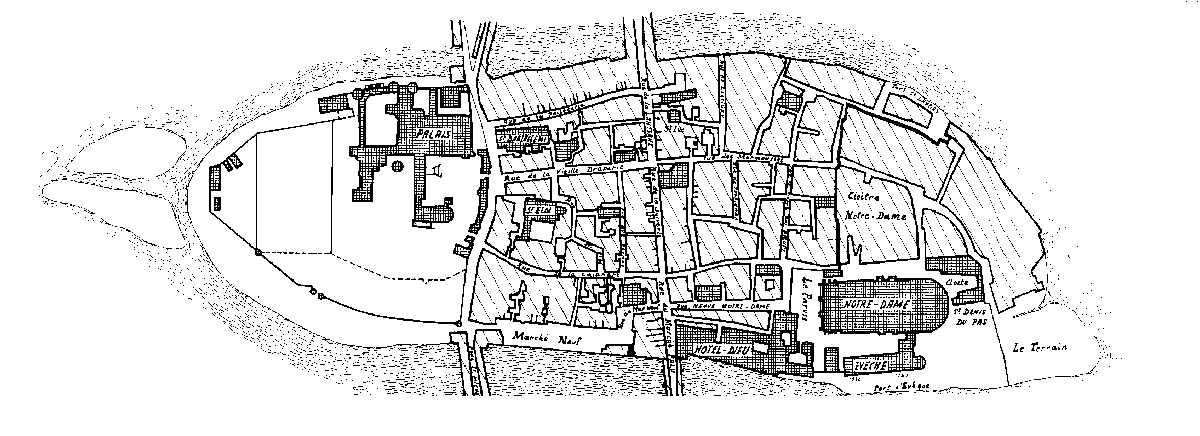
The Palace and its treasures were walled off at the western end of the Island; the Cathedral close, with its cloisters and Bishops Palace (Évéché) was behind another wall to the East. Between them, a maze of tiny streets, traversed by the main street between the Petit Pont (top right) and Pont Notre-Dame. The Pont saint-Michel was named after a chapel of St.. Michael in the palace precincts. The fourth bridge was the Pont au Change, where the money-changers had their shops all the bridges, of course, were lined with houses. Note finally, bottom centre, the Hôtel-Dieu, Paris first hospital. still there today but at the other side of a much enlarged Place du Parvis.
On the Left Bank, Saint-Louis reign produced an institution. In 1253, at the request of a University teacher, Robert de Sorbon, the King founded a College, a place where students could live and work until then, lectures had mostly taken place in the open air. This oldest of many colleges is still called the Sorbonne, though its buildings are all of a much later date.
Saint Louis grandson was Philippe le Bel, notorious for the suppression of the Order of Knights Templar, the first of the series of accursed Kings written about by Maurice Druon. The Templars were burned at the stake on one of the little marshy islands West of the Cité, known from then until its incorporation into the Square du Vert-Galant as the Ile des Patriarches.
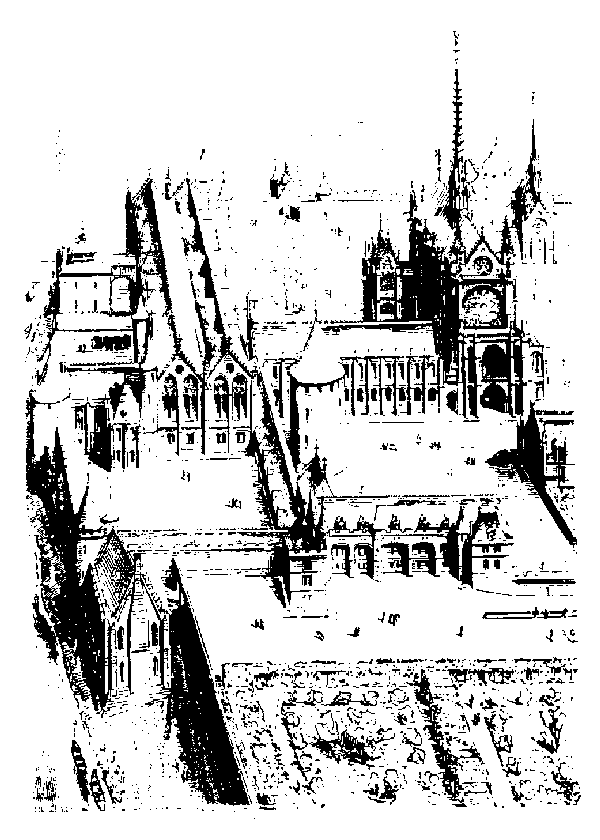
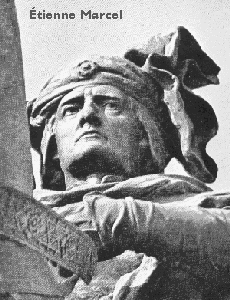 Philippe left his mark on
Paris in the Palais de la Cité, the remains of which are known
today as the Conciergerie. Three of its Gothic halls survive; the Salle
des Gens dames was in its day the largest hall in Europe. The three
round towers facing the river date from this time: Tour de
César, Tour d'Argent (the royal treasure-house) and Tour
Bonbec, oldest of all, which got its name (Bonbec means chatterbox)
from the efficacy of its torture chambers. The quayside in front of
the Conciergerie was built up in the 16th Century, hiding the bottom
twenty feet of each tower.
Philippe left his mark on
Paris in the Palais de la Cité, the remains of which are known
today as the Conciergerie. Three of its Gothic halls survive; the Salle
des Gens dames was in its day the largest hall in Europe. The three
round towers facing the river date from this time: Tour de
César, Tour d'Argent (the royal treasure-house) and Tour
Bonbec, oldest of all, which got its name (Bonbec means chatterbox)
from the efficacy of its torture chambers. The quayside in front of
the Conciergerie was built up in the 16th Century, hiding the bottom
twenty feet of each tower.
Perhaps because of the curse, France had eight Kings in the course of the next fifty years. Paris itself, however, prospered perhaps because of the preoccupation of the Kings with disastrous foreign affairs. The Parliament, never a very powerful institution in France, was able to assert itself at least in local affairs. Much building went on, including the church of St.-Leu-St.-Gilles in Rue Saint-Denis. By 1358 the King was a prisoner in England and the Parliament, under the leadership of Étienne Marcel, was in open revolt. The mob broke into the apartments of the Dauphin (the title held by the heir to the throne in France), the future Charles V, and murdered his advisers. He fled to the Hôtel Saint-Paul on the Right Bank, and the Palais de la Cité ceased to be a royal residence. Étienne Marcel, incidentally, proceeded to go too far and proposed handing Paris over to the English; whereupon he was murdered in his turn. He remains a symbol of the independent spirit of Paris.
The presence of King Charles V at the Hôtel Saint-Paul made
the Marais a fashionable area; many courtiers and noblemen built
houses there. Parts of these survive, including the Hôtel des
Tournelles and the gateway of the Manoir de Clisson, now an entrance
to the National Archives.
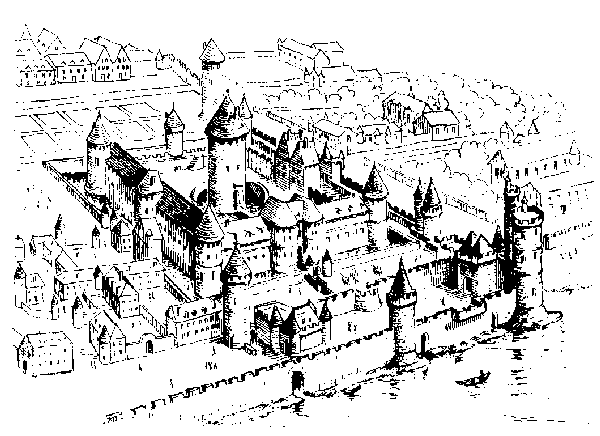 At the same time, the Louvre was converted to a residence, and the Kings
library was installed there. The square tower at the corner of the
Conciergerie by the Pont au Change was fitted with Paris first
public clock in 1370. However, Charles Vs strongest mark on Paris
was his extension of the city walls to include this new residential
area, including the construction of a fortress to guard the East of
Paris as the Louvre guarded the West. Next to the Porte Saint-Antoine
arose the Bastille Saint-Antoine, thereafter known simply as La
Bastille.
At the same time, the Louvre was converted to a residence, and the Kings
library was installed there. The square tower at the corner of the
Conciergerie by the Pont au Change was fitted with Paris first
public clock in 1370. However, Charles Vs strongest mark on Paris
was his extension of the city walls to include this new residential
area, including the construction of a fortress to guard the East of
Paris as the Louvre guarded the West. Next to the Porte Saint-Antoine
arose the Bastille Saint-Antoine, thereafter known simply as La
Bastille.
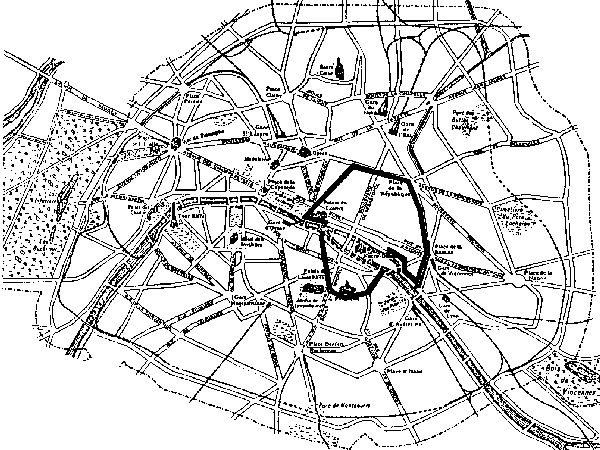
The Fifteenth Century was not a good time for Paris. Under the accursed Kings, the Kingdom of France had shrunk to a tiny area, the rest of the country being constantly fought over by Armagnacs, Burgundians and English. Jean Sans-Peur (the fearless), Duke of Burgundy, lived in Paris for a time. In 1408, frightened by the reaction to his assassination of the Duke of Orleans, he fortified his house already attached to the city walls with a tower which still stands in the Rue Étienne-Marcel. The Hôtel de Sens also dates from this century.
In 1413 the Pont Notre-Dame was rebuilt, still in timber and still lined with houses; but these houses, for the first time in Paris, were given numbers. It was a good idea, and might have caught on if the town had not fallen to the English, who occupied it from 1420 to 1437 despite the best endeavours of Joan of Arc. The statue of Joan in Place des Pyramides is close to the site of the Porte Saint-Honoré where in 1429 she was wounded in the thigh by an arrow while testing the depth of the moat with her spear.
3: Paris in the Renaissance
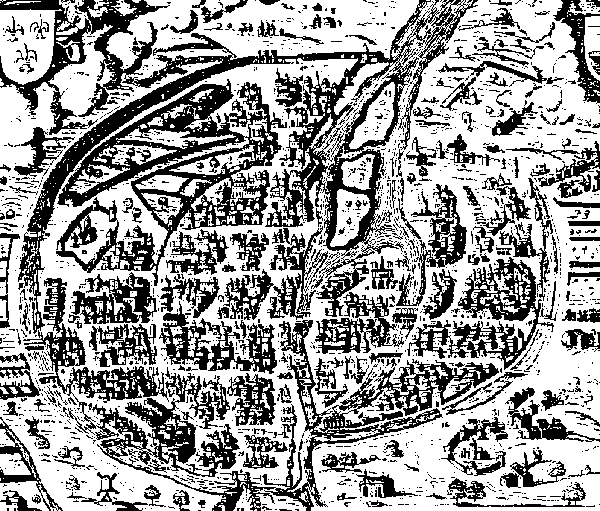
The Sixteenth Century, like the Fifteenth, started with work on the Pont Notre-Dame, which this time was rebuilt in stone though still lined with houses. In an age without artificial sanitation, there were obvious advantages in living over a river. A new period of expansion began when Louis XII was succeeded by François I in 1515. In the same year, victory at Marignan made him Duke of Milan and opened France to Italian influence. Italian painters and designers, including Leonardo da Vinci, flocked to the French court. At first, this led to more building in the Marais, where the King occupied the Hôtel des Tournelles. The area known as the Village Saint-Paul, between St. Paul's church and the river, dates from this period. It was just outside the Philippe-Auguste walls, and a section of the wall can still be seen behind the garden in the Rue des Jardins Saint-Paul.
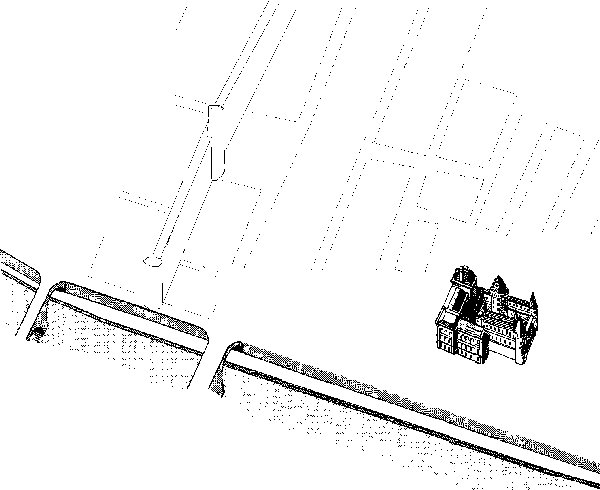
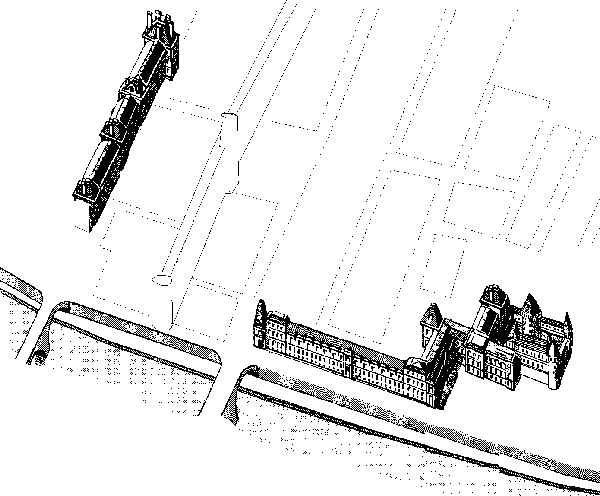 François I, however, was never still for long, and a
compulsive builder. Besides Chambord and other châteaux on the
Loire, he determined to build a palace in Paris in the very latest
style, and employed Pierre Lescot as architect and Jean Goujon as
sculptor on the ambitious project of a new Louvre. The L-shaped building surrounded the old
Louvre on two sides, so that the building now had two Gothic faces
(North and East) and two Renaissance. François himself died
the year after work began, but building went on under his son, Henri
II.
François I, however, was never still for long, and a
compulsive builder. Besides Chambord and other châteaux on the
Loire, he determined to build a palace in Paris in the very latest
style, and employed Pierre Lescot as architect and Jean Goujon as
sculptor on the ambitious project of a new Louvre. The L-shaped building surrounded the old
Louvre on two sides, so that the building now had two Gothic faces
(North and East) and two Renaissance. François himself died
the year after work began, but building went on under his son, Henri
II.
All this building cost money; and Henri's counsellors provided it by advising the King to marry Catherine de Medici, heiress of the richest family in the world, the Medici bankers of Florence. When Henri was killed by accident during a tournament, Catherine, Regent during the minority of her sons François II and Charles IX, needed a palace of her own. She chose a site half a kilometre from the Louvre and outside the walls, where she pulled down an old tile-factory (Tuilerie) so that her architect Philibert Delorme could build the long, narrow Palais des Tuileries. Realising that people would need to get from one palace to the other even in bad weather, she also started work on a long gallery connecting the two. This was half-finished in 1572 when the St. Bartholomew's Day massacre of Protestants started the Wars of Religion.
Meanwhile, the town too was moving Westwards. Fashion began to desert the Marais for the area North of the Louvre and Tuileries. New monuments went up either side of the Cimetière des Innocents; to the South the Fontaine des Innocents designed by Pierre Lescot, a three-sided structure against the cemetery wall; and to the North the church of Saint-Eustache, in outline the last great Gothic church of Paris, but in its detail firmly Renaissance.
4: Classical Paris
Before Henri III was forced to leave Paris in 1588, he had ordered the building of a new bridge across the Seine at the Western end of the Ile de la Cité. Perhaps it is the fault of his enmity to the capital that Parisians always attribute this monument to his successor.
Not that it was apparent at the time who should succeed this childless King. Displeased with the Catholics who had opposed him in Paris, he settled the succession on a Protestant monarch, Henri III of Navarre, who happened also to be a descendant of Saint Louis. The two of them besieged Paris together until the French King was assassinated by a fanatical monk. His distant cousin, now Henri IV, declared pragmatically that Paris was worth a Mass, converted to Catholicism and entered his capital in triumph in 1589.
This was the start of a Golden Age. During the reign of Henri IV
the area of Paris increased by a third while its population doubled.
Town Planning came into its own, and many projects were begun under
Henri IV to be finished in the reigns of Louis XIII and XIV.
For a
start, the Pont Neuf was finished.
This New Bridge is now the oldest in Paris, but at the time it
represented a revolution. There were no houses on it, and the
pavements were raised above the carriageway. People flocked to see
it, pedlars flocked to sell to the visitors, and the bridge became a
sort of permanent fairground. Just to the East of the bridge, the
President of the Parlement de Paris (essentially a judicial body)
obtained permission to lay out a wide square, the first of those
Parisian open spaces originally known as Places Royales. This was the
Place Dauphine, nowadays tree-lined and shady, an oasis of calm at
the centre of the city.
Henri IV, who had gone on record as saying that he wanted every family in France to have a chicken in the pot on Sundays, remains the most popular of French Kings. His many love-affairs are admired, as is especially his determination to keep the people happy by giving them work. Needing money for the purpose, he followed tradition and married a Medici; Marie de Médicis, who brought with her fabulous wealth and another batch of Italian artists plus, surprisingly, Rubens, who was her favourite painter.
In the Marais, the Hôtel des Tournelles, redundant now that the King lived at the Louvre, was pulled down to make way for another great square, the Place Royale (now the Place des Vosges). This square is unchanged (and recently restored) today; built of red brick and stone, surrounded by shady arcades, with at its centre a statue of Louis XIII, for by the time it was completed, Henri IV had in turn been assassinated by a fanatical monk. at his death the Louvre was now firmly attached to the Tuileries, with the medieval castle still anachronistically enclosed in the Cour Carrée.
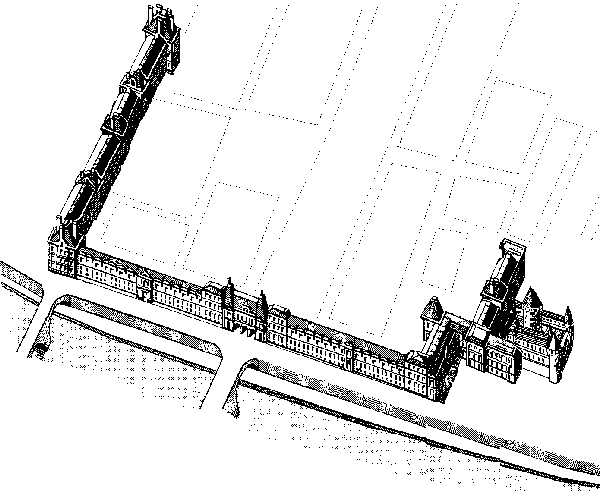
 Once more an Italian Queen was Regent for her infant son; and once
more she built herself a palace. This time it was the Palais du
Luxembourg, a vast extension to the Town House of the Counts of
Luxembourg, designed by Salomon de Brosse. (This is now the seat of
the Sénat, the Upper House of the French Parliament, whose
President lives in the old building, the Petit Luxembourg.) Her
adviser, Cardinal Richelieu, also built himself a palace, then called
the Palais-Cardinal, just to the North of the Louvre. In memory of
Henri IV, his widow erected an equestrian statue on the Pont-Neuf, a
copy of which stands there to this day. Louis XIII eventually managed
to rule for himself, having exiled his formidable mother twice over
for interfering in Government (a series of ghastly paintings by
Rubens, now in the Louvre, records the ups and downs of her eventful
life), made his mark on Paris by building walls. The old ramparts of
Philippe-Auguste and Charles V were now well inside the town, victims
of their own success in attracting people to the security of a
well-defended Paris. Louis enclosed the new suburbs on the Right
Bank. The
Left Bank, still mainly University, had not shared in the expansion.
Between the two, however, a speculative builder called Christophe
Marie (the Pont Marie is named after him) obtained permission to join
together and build over the little marshy islands to the East of the
Cité., thus forming the Ile Saint-Louis, and elegant and
aristocratic extension to the Marais and a sound investment for Marie
and his friends.
Once more an Italian Queen was Regent for her infant son; and once
more she built herself a palace. This time it was the Palais du
Luxembourg, a vast extension to the Town House of the Counts of
Luxembourg, designed by Salomon de Brosse. (This is now the seat of
the Sénat, the Upper House of the French Parliament, whose
President lives in the old building, the Petit Luxembourg.) Her
adviser, Cardinal Richelieu, also built himself a palace, then called
the Palais-Cardinal, just to the North of the Louvre. In memory of
Henri IV, his widow erected an equestrian statue on the Pont-Neuf, a
copy of which stands there to this day. Louis XIII eventually managed
to rule for himself, having exiled his formidable mother twice over
for interfering in Government (a series of ghastly paintings by
Rubens, now in the Louvre, records the ups and downs of her eventful
life), made his mark on Paris by building walls. The old ramparts of
Philippe-Auguste and Charles V were now well inside the town, victims
of their own success in attracting people to the security of a
well-defended Paris. Louis enclosed the new suburbs on the Right
Bank. The
Left Bank, still mainly University, had not shared in the expansion.
Between the two, however, a speculative builder called Christophe
Marie (the Pont Marie is named after him) obtained permission to join
together and build over the little marshy islands to the East of the
Cité., thus forming the Ile Saint-Louis, and elegant and
aristocratic extension to the Marais and a sound investment for Marie
and his friends.
When he died in 1642, Cardinal Richelieu was careful to leave his palace to the King. Louis XIII, however, died soon after his great Minister, leaving a five-year-old King and a Queen Mother (Anne of Austria, which made a change) as Regent. The two of them moved into the Palais-Cardinal, renamed it Palais-Royal, and the longest reign in French history began.
Louis XIV was by any standards a remarkable person. His early childhood was spent in flight from civil war, while the great noblemen fought over his kingdom like starlings on a bird-table, each one eager to take advantage of the Kings youth. His mother, however, put her entire trust in her adviser, Cardinal Mazarin, who managed by cunning and statecraft to maintain the status quo until the young King was old enough to rule for himself. From that moment on, there was only one master in France. Nobles who had lived by sword and saddle in 1640 were within twenty years scheming and intriguing for the right to hold the Kings shirt at six o'clock in the morning. Dukes and Counts with vast estates and echoing mansions were pleased to live three to a room in the attics of Versailles, simply to be near the King. By the end of the Seventeenth Century the whole nobility of France feared nothing so much as a frown from this one mastering spirit. Provinces and neighbour states which had been enemies or uncertain friends for centuries became under his persuasion or by the force of his arms integral parts of France.
Here was a king, too, who shared with François I the fever of building. With armies of soldiers and armies of builders, he created full employment in France for most of the century. All around Paris he built or embellished a necklace of palaces; Saint-Germain, Saint-Cloud, Marly, Rambouillet, Fontainebleau, and most of all, above all, before all, Versailles; Versailles his grand design and the heart of his policy; Versailles where those who had threatened him could be taught to dance to their masters tune.
Paris, however, though seldom visited was never neglected. The work of building Paris was entrusted to a man later to be famous as the founder of the French Navy. Jean-Baptiste Colbert, a protégé of Cardinal Mazarin, in his first important post as Surintendant des Bâtiments, proved to be a town-planner of no little talent, well-served by splendid architects. Colbert's first task was to consolidate the new walls. He embellished the gates with triumphal arches, as at the Portes Saint-Denis and Saint-Martin. He had the old walls of Philippe-Auguste pulled down and streets laid out where they had been, thus inventing the ring road. Streets were paved and lit, and dotted here and there with a new feature of the Paris landscape, the open space. The Jardin des Tuileries, already open to the public, was landscaped by Le Nôtre, who went on to design the gardens at Versailles; François Mansart, an architect employed at Versailles, recommended his great-nephew Jules Hardouin-Mansart, who designed the Place Vendôme and the Place des Victoires in emulation of Henri IVs Place Royale. These were Royal squares, designed round statues of the King, and successive revolutions have smashed the statues and replaced them with ideas of their own, not always in keeping with the architects intentions. It takes a real effort of imagination to see what these places looked like when they were new. Place Vendôme, a rectangle proportioned according to classical principles, its corners cut off at just the right distance to offset the equestrian statue of Louis XIV in the centre, is overpowered by the vast column that Napoleons pride erected in place of the King; Place des Victoires, which seems cramped and claustrophobic around the rather vulgar bronze of the King on horseback, was originally designed as a perfect circle, sweetly proportioned to the standing figure at its centre
.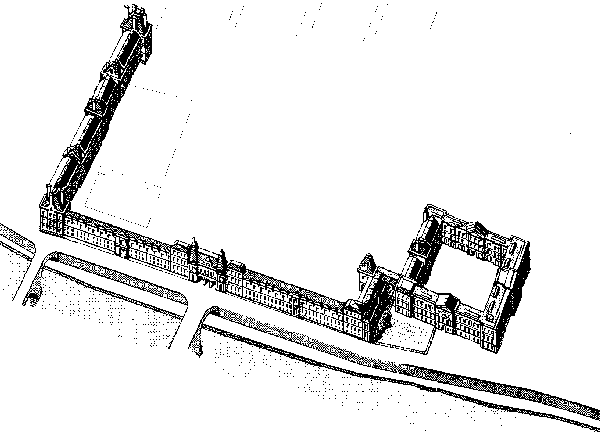 Proportion was the watchword; grandeur, glory, classical elegance. François I's Renaissance Louvre was
extended to a perfect square, the Cour Carrée; the old
medieval fortress Louvre, no longer part of the towns defences, was
demolished; its foundations can still be visited in the cellars of
the replacement Louvre. The Eastern façade was embellished
with a colonnade by Perrault. New churches were begun, like
Saint-Sulpice and Saint-Roch, to serve areas beginning to develop in
the empty spaces just inside the new walls. And on the Left Bank
especially, a series of domes. The dome was the emblem and symbol of
the age; rounded, italianate, classical in spirit, serene. To the
South of the University quarter was the convent of the Val de
Grâce, the masterpiece of François Mansart; in the very
centre the Chapel of the Sorbonne, another example of the style known
in France as Jesuit, begun under Louis XIII by Le Mercier. North of
that, on the river, the Tour de Nesle, now well inside the
fortifications, was replaced by Cardinal Mazarin's last brainchild,
the Collège des Quatre Nations, now called the Institut de
France, home to various learned bodies and pre-eminently the
Académie Française, whose sessions are held under its
rounded dome. To the East rose the dome of the
Salpétrière hospital designed by Libéral Bruand,
and to the West the masterwork of all, the Hôtel National des
Invalides.
Proportion was the watchword; grandeur, glory, classical elegance. François I's Renaissance Louvre was
extended to a perfect square, the Cour Carrée; the old
medieval fortress Louvre, no longer part of the towns defences, was
demolished; its foundations can still be visited in the cellars of
the replacement Louvre. The Eastern façade was embellished
with a colonnade by Perrault. New churches were begun, like
Saint-Sulpice and Saint-Roch, to serve areas beginning to develop in
the empty spaces just inside the new walls. And on the Left Bank
especially, a series of domes. The dome was the emblem and symbol of
the age; rounded, italianate, classical in spirit, serene. To the
South of the University quarter was the convent of the Val de
Grâce, the masterpiece of François Mansart; in the very
centre the Chapel of the Sorbonne, another example of the style known
in France as Jesuit, begun under Louis XIII by Le Mercier. North of
that, on the river, the Tour de Nesle, now well inside the
fortifications, was replaced by Cardinal Mazarin's last brainchild,
the Collège des Quatre Nations, now called the Institut de
France, home to various learned bodies and pre-eminently the
Académie Française, whose sessions are held under its
rounded dome. To the East rose the dome of the
Salpétrière hospital designed by Libéral Bruand,
and to the West the masterwork of all, the Hôtel National des
Invalides.
Les Invalides was a vast project; a home for soldiers wounded in Louis XIV's many wars, and an expression of the glory of French arms. Libéral Bruand planned the whole place, the vast arcaded Cour d'Honneur perfect in proportion, surrounded by a host of minor courtyards. In the centre was Bruand's church of Saint-Louis, and this was back-to-back with a second church, from which it is separated by a clear glass window; the church of the Dome, designed by Hardouin-Mansart. A gilded dome, this one, and highest of them all , catching and reflecting the sun which was the symbol of its master, the Sun King, le Roi Soleil.
Meanwhile in the Marais a quiet revolution had begun. Here it was architecture that was inventing modern France. The Marais had been essentially an aristocratic place; but now that the nobles had moved to Versailles, their gorgeous mansions were up for rent and a new class of person moved in. These were the people through whose hands passed all the new prosperity of France: merchants, bankers, lawyers, judges, ministers, councillors, the rising Middle Class in its every degree, along with their servants, employees, relatives and friends. Between the great mansions went up whole streets of a new sort of building, the immeuble, imposing on the town a new social structure; not horizontal as in London, where the rich lived in the West and the poor in the East; but vertical and close. On the ground floor, their heads brushing the low vault, lived the tradesmen, shopkeepers, caretakers and grooms; doors big enough for carriages led through the building to the inner courtyard and the stables. The wealthy lived on the first floor, with high ceilings, tall windows, elegant balconies, suites of reception rooms opening out of each other. Above them, the rent gradually decreasing with the height, lived the lesser bourgeoisie and the menu peuple, the poorest of all in the garrets under the lead roof, a Mansard roof of a new design by Jules-Hardouin Mansart, invented to cram as many people as possible into a building limited by decree to six storeys in height. This decree alone might be said to be responsible for much of the shape of modern Paris; it imposed a certain uniformity of design.
As the country prospered, more new wealth came to the Marais. Now that the area is being thoroughly restored, whole streets and districts of the Seventeenth and Eighteenth Centuries can be explored: Rue de Sévigné, Rue du Parc-Royal, Rue Payenne, Rue des Francs-Bourgeois; François Mansart's Hôtel Carnavalet (now the Museum of Paris) with its three enchanting garden courtyards; Hôtel Guénégaud (now the Hunting Museum) by the same architect ; Hôtel Libéral Bruand to prove that the architects, too, were making money; a hundred mansions and a thousand houses.
The reign of Louis XIV, longest-lived of all French Kings, went on into the Eighteenth Century; and the building went on after him into Louis XV's. time. Under this less stringent rule, the aristocracy began to creep back to Paris, building anew in the Western suburbs, les faubourgs. A new type of house, these in the Faubourg Saint-Germain and Faubourg Saint-Honoré; two storeys as often as not, many windows; light and airy, hidden behind high walls, with a courtyard at the street side and a garden at the other. The Élysée Palace, where the President lives, is a fine example, as is the British Embassy; both in the Rue du Faubourg Saint-Honoré. Across on the Left Bank in Saint-Germain, the Palais-Bourbon (now the Assemblée Nationale) and the delightful Hôtel Biron, now the Musée Rodin. These new suburbs, of course, are now well inside Paris; but you can trace the line of the old walls well enough on the map by looking for the Boulevards, a word that means bulwarks, or protective walls. Wherever a main street crosses the line, its name changes; Rue Saint-Honoré becomes Rue du Faubourg Saint-Honoré, Rue Saint-Denis becomes Rue du Faubourg Saint-Denis as it passes through the arch of Porte Saint-Denis; and so on.
Throughout the eighteenth century, while royalty turned its back on new building, the fever of construction gripped the new middle class. Whole districts sprang up; Chaussée d'Antin, Monceau, the Sentier and the areas now known as the Grands Boulevards, everywhere the immeubles for rent. For the next two hundred years the French for a private income was des rentes. Streets were named and the names posted up; houses were numbered. After a spate of fires which destroyed the Pont au Change, the Opera House, the old Palais de la Cité (which was replaced with the law courts), all the houses on all the bridges were pulled down to turn the river into a giant firebreak; and a M. Sartine, Lieutenant of Police, founded the Paris Fire Brigade. The main sewer was covered over; fountains and pumps brought running water to every district. The Cité, the Latin Quarter and the Louvre area were still a mass of narrow, insanitary alleyways; though the Louvre and the Tuileries were connected by the Galerie du Bord de l'Eau, it was still impossible to see from one palace to the other. Corners of the Louvre itself, neglected and crumbling during the long absence of the Kings, filled up with squatters, their stove-pipes punctuating the façade.
Twelve hundred years after her death, a public subscription raised money to build a church of Sainte-Geneviève on the hill that bore her name. Designed in the grand manner by Soufflot, its vast dome reached the sky in 1789, a poor time to be opening a church. But in the reign of Louis XVI, not a great builder and anyway short of money, architecture for the first time became the instrument of revolution.
It was like this: the King was short of money. Louis XIV's
extravagance had finally come home to roost. Technically, no new
taxes could be raised without calling a Parliament, and descendants
of Louis XIV would do anything rather than call a Parliament; so more
money had to be raised on the old taxes, including the Customs Duties
on goods entering Paris from the countryside. Yet here were all these
new suburbs outside the walls, whose people paid no duties. So the
tax-farmers got together and built a new wall, the Mur des
Fermiers-Généraux.
 It
was a very elegant wall, its gates provided with pavilions designed
by Nicolas Ledoux, still standing many of them, at Denfert-Rochereau,
Parc Monceau, the Rotonde de la Villette, Place de la Nation; but a
wall designed not for defence but simply for taxation.
Untranslatably, they said Le mur murant Paris rend Paris murmurant.
It
was a very elegant wall, its gates provided with pavilions designed
by Nicolas Ledoux, still standing many of them, at Denfert-Rochereau,
Parc Monceau, the Rotonde de la Villette, Place de la Nation; but a
wall designed not for defence but simply for taxation.
Untranslatably, they said Le mur murant Paris rend Paris murmurant.
Still within the walls was the Cimetière des Innocents, its
charnel-houses stuffed to bursting, far more dead people in Paris
than live ones, its soil famous for its ability to eat a corpse in
less than five years, a stinking, rotten pest-hole of a vast
enclosure right next to the central markets.
 In
1786 it was finally cleared away, nothing left but Pierre Lescot's
beautiful fountain, six million skeletons taken in an endless
procession of farm carts (they called them tumbrils) to the catacombs
formed by worked-out underground stone quarries beneath the hollow
hills of the South, Montrouge, Montsouris, Montparnasse. It was time
for clearing out the dead.
In
1786 it was finally cleared away, nothing left but Pierre Lescot's
beautiful fountain, six million skeletons taken in an endless
procession of farm carts (they called them tumbrils) to the catacombs
formed by worked-out underground stone quarries beneath the hollow
hills of the South, Montrouge, Montsouris, Montparnasse. It was time
for clearing out the dead.
One of the most popular of the new open spaces in Paris was just to the South of Les Innocents; the Palais-Royal, where the Duc d'Orleans had surrounded his gardens with a row of arcaded shops , and elegant apartments above them. It was here, on a bright morning in July 1789, that a young man called Camille Desmoulins leapt on a café table and told a panicky mob that the king was sending his soldiers to attack Paris; that Paris had better arm itself for defence; and that arms could be found at the Bastille. At that moment, to the very second, the Golden Age came to an end.
5: Revolution and Empire
Revolutions, however inevitable, are not essentially constructive. Churches, abbeys, convents came tumbling down; some on pure anti-clerical principal, others to make way for speculative building. Saint-Jacques-la-Boucherie, after three centuries, was destroyed in 1802. Arbitrarily, the tower was bought by a manufacturer of lead shot and, though gutted, survived. The bones of Kings, Queens and Saints were dug up and thrown on bonfires. Sainte-Geneviève lost her new church, which became the Panthéon, secular burial place of fashionable heroes. Everything changed its name according to ideology or whim. Place Louis XV became Place de la Révolution. Statues (especially the wonderful pairs of horses by Coustou and Coysevox) were brought from the abandoned palace of Marly to embellish the square. Place Royale was renamed Place des Vosges when the new Département of the Vosges was the first to pay its taxes to the new régime. Notre-Dame became the Temple of Reason, the Sainte-Chapelle a storehouse, the Conciergerie the gateway to the guillotine.
Certainly, plans were made; artists, too, have revolutionary ideas. A Commission of Monuments was founded, but in a day when the Government, even the Constitution, could change overnight, little was actually done. The stones from the Bastille were used to construct a bridge, now the Pont de la Concorde, so that the tyrant's prison would forever be trampled underfoot; but that was ideology, not architecture. In all the turmoil, however, one great institution was born: the Musée du Louvre. Though the Tuileries remained a palace, the Louvre was given to the people. The Grande Galerie opened to the public on 10th August 1793. The Kings had been collecting loot since François I arrived home with Leonardo; but the greatest hours were just to come.
It seems to be an essential condition for a period of expansion in a city's building that a strong guiding hand be applied from the top. Filling the vacuum left by the Revolution, Napoléon I, in his remarkably short reign as Consul and Emperor from 1799 to 1814, supplied this guiding hand. Paris, he said, was to be not only the most beautiful town in existence, the most beautiful town which had ever existed, but the most beautiful that could possibly exist. And his idea of beauty was heavily involved with glory, La Gloire, a word that sums up the aim of all Napoléon's projects. This was an age of monuments designed to impress. Few of them were finished during the First Empire. The Arc de Triomphe de l'Étoile, the world's largest triumphal arch, designed by Chalgrin in 1806, faked in wood and canvas for the entry of Empress Marie-Louise in 1810, was abandoned for twenty years while the Emperor died on St. Helena, and was completed in time for his state funeral in 1840. The Madeleine, designed by Vignon as a temple to the glory of the French army replacing previous plans for a church and a stock exchange was considered as a railway station before being finally completed and consecrated in 1840.
Other things were completed, though. The Place du Châtelet is a creation of the Empire, with its two vast theatres framing the view across the Pont au Change, and a central monument commemorating the victories of the young Napoléon. The Pont des Arts, joining the Louvre to the Institut, was the first iron bridge in France. A whole succession of bridges reflect the new technology of the dawning century. Napoleonic monuments, including the monstrous column in the Place Vendôme, replaced royal ones recently destroyed.
Other aspects of urbanism were not neglected. A new street, Rue de Rivoli, was driven from East to West between the square now renamed Place de la Concorde and the seventeenth-century Hôtel de Ville. In imitation of Italian towns captured by the Emperor, it was arcaded along its length. The waters of the river Ourcq were brought in from the North in a vast aqueduct to the Bassin de la Villette, and the fountains on every street corner ran day and night. The streets were better paved, the sewers extended. The population increased and built itself new, crowded suburbs, and immigrants came from every corner of the vast new Empire.
 The greatest work, though, was at the Louvre. From every corner of Europe the tribute
poured in to swell the nation's collection and the Emperor's pride.
The dream arose of a grand, symmetrical, complete Louvre, an enclosed
kingdom of the Arts. The old streets inside this enclosure were swept
away, and the first finger of a Northern gallery crept out from the
Tuileries towards the Cour Carrée. The old buildings of the
North, East and South had an extra storey added. In the centre of the
open space, at the entrance to the still-private courtyard of the
Tuileries, arose a little masterpiece, the Arc de Triomphe du
Carrousel, and to decorate this arch came the cream of all the
spoils; the bronze horses from the roof of St. Mark's in Venice.
The greatest work, though, was at the Louvre. From every corner of Europe the tribute
poured in to swell the nation's collection and the Emperor's pride.
The dream arose of a grand, symmetrical, complete Louvre, an enclosed
kingdom of the Arts. The old streets inside this enclosure were swept
away, and the first finger of a Northern gallery crept out from the
Tuileries towards the Cour Carrée. The old buildings of the
North, East and South had an extra storey added. In the centre of the
open space, at the entrance to the still-private courtyard of the
Tuileries, arose a little masterpiece, the Arc de Triomphe du
Carrousel, and to decorate this arch came the cream of all the
spoils; the bronze horses from the roof of St. Mark's in Venice.
And then, but for a little hiccup lasting a hundred days, it was all over. The Empire gone, the Revolution swept away. Little fat Louis XVIII, as ineffective as his late brother, was in the Tuileries and building stopped. Under Louis XVIII and his son Charles X, from 1815 to 1830, the Étoile remained a building site, the Madeleine a wasteland. A tiny pavilion was added to the North corner of the Louvre, and the Canal Saint-Martin was completed between the Seine and La Villette; and that was all.
In 1830 a new Revolution finally swept away the old royal family of Bourbon, replacing them with a constitutional monarchy under a distant cousin, Louis-Philippe d'Orléans. Here was a King of less aristocratic character, and one content to live in Paris. Versailles was not for Louis-Philippe, who was uncomfortable with its grandeur. He spent his summers as often as not at Eu in Normandy, where he built a château more suited to his taste for cosiness and carpet-slippers.
Because the Revolution had taken place in July, Louis-Philippe laid out a vast new square where the Bastille had been before July 1789, and in the centre erected the July Column with an inscription on its base in memory of those who had died to put him on the throne. Because he was essentially a housekeeper by habit of thought, Louis-Philippe's work on Paris mainly consisted of a very welcome tidying-up. The Place de l'Étoile was properly laid out and the Arc de Triomphe finished; the half-built Madeleine was dug out of its weeds. Hittorff was commissioned to complete the Place de la Concorde, using as centrepiece the immense obelisk donated by the Pasha of Egypt, and adding, in the words of the music-hall song, statues and fountains all over the place. The last of the Seine islands were tamed; the Ile des Cygnes, on which a little work had been done under Charles X, was completed and its pleasant walk laid out. The Ile Louviers, between the Ile Saint-Louis and the Bastille, was attached to the Right Bank and filled with local government buildings. Many of the monuments that had suffered during the Revolution were patched up or completely restored. Viollet-le-Duc, the greatest nineteenth-century authority on the Gothic, restored the Sainte-Chapelle and Notre-Dame. The latter, indeed, was in grave danger of collapse, and the restorer's work had to be done with a good deal of imagination. That slender spire, for example, with its green saints, is entirely the work of Viollet-le-Duc; those hideous gargoyles, where one might imagine Quasimodo swinging, are all of the Nineteenth Century.
Meanwhile, the Marais was crumbling. Consider; its great houses had been built for the nobility, then taken over and added to by the rich middle class. Noblemen building in Paris had moved West, to Saint-Germain and Saint-Honoré; and then the nobility had been exiled, massacred or impoverished. The rich middle class of the Restoration, and especially under Louis-Philippe, the middle-class King, moved into the western mansions. The great houses of the Marais were divided up and let; the lesser houses further subdivided for the poor. The ground-floor stables became workshops and small factories, especially producing furniture. Slowly, the great façades began to crumble.
 Finally, Louis-Philippe and his minister, Thiers, built walls. Not
tax walls this time, but genuine military fortifications, all round
the new Paris, with a belt of cleared land giving a field of fire, a
railway line running all round just inside the defences, and a ring
of forts a cannon-shot outside the walls; modern, scientific defences
catering to the paranoia of a people who had been invaded and
occupied twice in the past thirty years. The old walls, except for
the prettier pavilions of Nicolas Ledoux, were razed and turned into
ring roads, the Boulevard Extérieur. The edge of the fortified
zone, with the addition of the Bois de Boulogne and Bois de
Vincennes, marks the boundary of Paris to this day.
Finally, Louis-Philippe and his minister, Thiers, built walls. Not
tax walls this time, but genuine military fortifications, all round
the new Paris, with a belt of cleared land giving a field of fire, a
railway line running all round just inside the defences, and a ring
of forts a cannon-shot outside the walls; modern, scientific defences
catering to the paranoia of a people who had been invaded and
occupied twice in the past thirty years. The old walls, except for
the prettier pavilions of Nicolas Ledoux, were razed and turned into
ring roads, the Boulevard Extérieur. The edge of the fortified
zone, with the addition of the Bois de Boulogne and Bois de
Vincennes, marks the boundary of Paris to this day.
Louis-Philippe lasted until 1848, when another revolution brought in the Second Republic, a short-lived régime whose only legacy to posterity was an inscription on the base of the July Column commemorating, with conscious or unconscious irony, those heroes who had died to remove Louis-Philippe from his throne.
6: Yesterday and Today
The Second Republic carried within it the seeds of its own destruction; its President was Louis-Napoléon Bonaparte, great-nephew of Napoléon I. Within four years, the Second Republic had become the Second Empire.
Like the July Monarchy, this was a middle-class, constitutional version of its original. Napoléon III also took his holidays at Eu, which he treated as a sort of French Balmoral, even to inviting Victoria and Albert over from time to time. His rule was essentially ineffective, and in the end disastrous; but his influence on Paris was profound.
Under Napoléon III, town planning in Paris was in the hands of the Préfet de la Seine, Baron Haussmann, a man neither ineffective nor hesitant. Under his orders, modern Paris was born. The purpose of this was half social, half political. Certainly, the popular quarters of Paris had degenerated into stinking slums which needed to be cleaned out before disease and squalor overwhelmed the city; but Haussmann, whose master had organised a revolution, was careful to remove as far as possible the conditions in which revolutions succeed. He criss-crossed the city with broad avenues difficult to barricade and easy to clear with cavalry; he laid out circuses at their intersections, from which artillery could have a clear field of fire in every direction: Place de la République, Place de la Nation, Place d'Italie. He tamed the remaining wild places in the city, converting quarries like the Buttes Chaumont and Montsouris and dumps into parks, rubbish tips like Montparnasse into squares and railway stations. Some of Haussmann's work was pure vandalism. He drove the Rue Monge clear across the edge of the newly-discovered Arènes de Lutèce, and demolished ruthlessly every private house, every tortuous alleyway of the Ile de la Cité. Sections of the Parc Monceau and the Jardin du Luxembourg were privatised and given over to luxury apartment blocks. Nothing stood in Haussmann's way. Even the Fontaine de Médicis had to be moved bodily from the path of the Boulevard Saint-Michel. Independent villages inside the new walls, such as Montmartre, were annexed into Paris. The Bois de Boulogne and de Vincennes, wasteland since the invasions of 1814 and 1815, were landscaped and replanted. To show all this off to the world, World Exhibitions, on the model of the Crystal Palace exhibition of 1851, were held in 1855 and 1867. All the crowned heads of Europe came, and the Emperor took them up to the hill of Montmartre to show the glories of his new city. The King of Prussia and his Chancellor, Bismarck, were, it seems, more interested in its defences.
Under each of Haussmann's straight new roads ran a straight new sewer. Sanitation, private water supply, gas lighting were brought to the people of Paris. Those not made homeless were duly grateful; but they were the Emperor's own middle class. Among the dispossessed poor, a hot resentment began to seethe, held down by a strong secret police, but terrible in its later effects.
 In public buildings, the majority of the effort went into the
Louvre. The encirclement of the central space was
completed, new courtyards added, two to a side, parallel to disguise
the divergence of the long arms which reached out to the Tuileries.
Part of this was Museum, part State apartments, part Government
Ministries. From the side entrance of the Louvre the grandest of the
Avenues led to the crown of the Emperor's plan, the new Opera House,
designed by the young Charles Garnier in what was to become the
style Napoléon III.
In public buildings, the majority of the effort went into the
Louvre. The encirclement of the central space was
completed, new courtyards added, two to a side, parallel to disguise
the divergence of the long arms which reached out to the Tuileries.
Part of this was Museum, part State apartments, part Government
Ministries. From the side entrance of the Louvre the grandest of the
Avenues led to the crown of the Emperor's plan, the new Opera House,
designed by the young Charles Garnier in what was to become the
style Napoléon III.
The Opéra, however, remained unique. Napoléon III had succumbed to the temptation to imitate his great-uncle. Believing the French army to be the best in the world, he was tricked by Bismarck into declaring war on Prussia, and discovered in a few disastrous weeks that his army was by a long way only the second best. The Emperor abdicated, the Third Republic was proclaimed, and Paris was besieged.
Louis-Philippe's military engineers had built well. Paris held out for six months, sending messages out by balloon, eating everything that moved, attempting feebly to break out of the Prussian ring; but the end was never in doubt. The Government of the new Republic surrendered the city early in 1871. They thought the result would be peace, but they were not Parisians. The result was revolution.
During the Siege every man in Paris, rich and poor, had been armed; but most of the rich had been able to leave before the ring was closed. Now the common people of Paris were forced to accept a peace they had not chosen, forced on them by a Government based in Versailles, and a Prussian march along the Champs-Élysées and a token occupation of their precious city for a day and a night. In the morning the women of Paris came out and scrubbed the streets wherever a Prussian had been standing, and Paris declared itself an independent Commune. No Parisian was taking orders from cowardly provincials. For a start the painter Courbet, now a member of the Commune, had the Vendôme column pulled down. It was out of proportion with the Square.
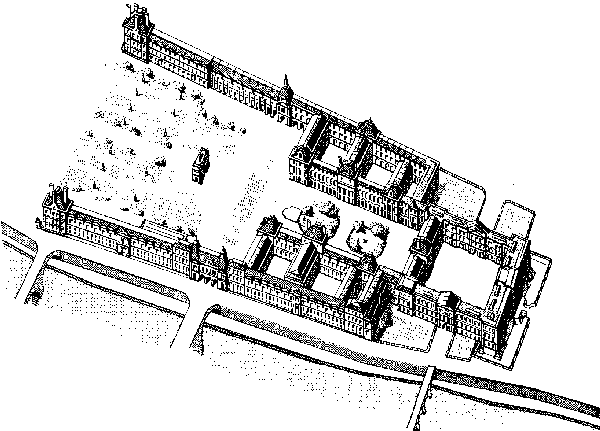 There were excesses, as in any revolution; generals murdered in
back gardens, the Archbishop taken hostage and eventually killed; but
the reply was even more atrocious. Centuries of provincial resentment
welled up, and the soldiers of France were unleashed on the people of
Paris. Once the army was inside the poorly-guarded walls, the end was
never in doubt; Haussmann's broad avenues saw to that. It took a
week, but by the end Paris was part of France again, with twenty
thousand of its citizens dead and as many more transported to South
America. In the process, unattended fire took hundreds of buildings,
including the headquarters of both sides; the Hôtel de Ville
and the Tuileries Palace. The complete Louvre had lasted only a year;
but a new vista had been opened up, la Grande Perspective, a
straight-line view through the heart of the city from the centre of
the Louvre to the Arc de Triomphe and beyond. At the far end of this perspective, on a
hill outside the walls, was erected a statue by Ernest Barrias to La
Défense, the Defence of Paris through the Siege. The
Vendôme column was replaced, and they sent the bill to Courbet.
There were excesses, as in any revolution; generals murdered in
back gardens, the Archbishop taken hostage and eventually killed; but
the reply was even more atrocious. Centuries of provincial resentment
welled up, and the soldiers of France were unleashed on the people of
Paris. Once the army was inside the poorly-guarded walls, the end was
never in doubt; Haussmann's broad avenues saw to that. It took a
week, but by the end Paris was part of France again, with twenty
thousand of its citizens dead and as many more transported to South
America. In the process, unattended fire took hundreds of buildings,
including the headquarters of both sides; the Hôtel de Ville
and the Tuileries Palace. The complete Louvre had lasted only a year;
but a new vista had been opened up, la Grande Perspective, a
straight-line view through the heart of the city from the centre of
the Louvre to the Arc de Triomphe and beyond. At the far end of this perspective, on a
hill outside the walls, was erected a statue by Ernest Barrias to La
Défense, the Defence of Paris through the Siege. The
Vendôme column was replaced, and they sent the bill to Courbet.
The Third Republic produced two of the most famous monuments of Paris. First, the Church decided on an Act of Expiation for the War of 1870, and from congregations all over France collected forty million francs to build a vast white basilica on the hill of Montmartre; the Sacré-Coeur. Replacing a windmill that had crowned the grassy hill for centuries, this was the one new building of a quarter of Paris essentially unaffected by Haussmann's iconoclasm, a haunt of artists, its old village streets and squares still to be seen today, though crowded with tourists. At the other side of town, another Great Exhibition, held in 1889 to commemorate the Fall of the Bastille produced a temporary monument, the worlds tallest building in its day, the Tower designed by France's most brilliant engineer, Gustave Eiffel. Cast iron was the material of the day, though more usually clothed in stone; along the Boulevard Haussmann, Eiffel designed domes for two new Department Stores (Galeries Lafayette and Printemps), and Baltard produced an iron-framed church, Saint-Augustin. In the very centre of Paris, the same Baltard designed the Central Markets, Les Halles, occupying the space left by the Cimetière des Innocents.
Many of the buildings and perspectives of Paris are the legacy of Exhibitions. Opposite the Eiffel Tower, on the Right Bank, the gardens and fountains on the slopes of the Chaillot hill were laid out for an Exhibition in 1878. The Moorish-style palace they surrounded, always intended to be temporary, was replaced by the present Palais de Chaillot in 1937. The Exhibition of 1900, when Paris was ahead of all Europe in celebrating the end of the century, gave us the Grand Palais, the Petit Palais, the single-span bravura Pont Alexandre III and the Gare (now Musée) d'Orsay.
New building materials came in at the turn of the century, and their first appearances, dotted around the capital, make a fascinating study. The Church of St. John the Evangelist, at the foot of the Butte Montmartre, by Baudot (1904) is of reinforced concrete faced with brick. Elsewhere, glass, metal, ceramics on the Place Beaubourg there is a perfect example of a public bath-house in the style, still in vogue, known as Style Bains-douche. The particular fashion of decoration known in England as Art Nouveau and in France, perversely as Moderne Style, reached its zenith in a house by Lavirotte in the Avenue Rapp, where the sinuous ironwork and flower-like carvings of the doorway reflect perfectly the spirit of the age. Greatest gift of all, the Chemin de Fer Métropolitain, the trusty Métro, still the world's finest (and cheapest) urban transport system, opened its first line in 1900 and has never stopped expanding. Many designers worked on the Métro too, notably Hector Guimard who designed the original Art Nouveau entrances with their bronze lily lamps or glass fan awnings
1914 put an end to all that. Paris was only lightly damaged by the First World War, but France lost a whole generation of young men. Depression and political turmoil followed, and recovery was only just under way in 1939. Four years of occupation followed by bombardment and a week of street battles did nothing to increase the country's prosperity, and the Fourth Republic which followed the war proved unstable in the extreme. Between 1945 and 1965 the only major building projects undertaken in Paris were the UNESCO building, an international undertaking, and the ORTF headquarters opposite the Ile des Cygnes. Considering the general awfulness of most immediate post-war designs, however, this was not altogether a Bad Thing.
Once General de Gaulle had founded the Fifth Republic, political stability began to foster a new prosperity. In 1965 a Plan for regional development was published, and the Louvre was embellished with a deep moat in front of Perrault's colonnade in the Place du Louvre. When Georges Pompidou succeeded de Gaulle in 1969, Paris had once again the strong guiding hand it needed a function which President Mitterand has continued in the fullest measure. First, the old fortifications zone was converted to a green belt, with a motorway, the Boulevard Périphérique, running all round between parks and sports facilities. All the old central markets were transferred out of Paris. Les Halles, the fruit and vegetable market, is now a park above a vast underground shopping centre. The meat markets at La Villette have become a vast Park with halls, sculptures, exhibitions and the Cité des Sciences; those in the South are now the Parc Georges Brassens. The wine markets at Bercy are even now blossoming into a new National Library, and across the river a whole new district is growing round a fresh finance Ministry and the Palais Omnisports, surrounded again by a new park. Among the first areas redeveloped were Montparnasse, where a mass of unfortunate brick-shaped blocks are topped by the soaring Tour du Maine, the tallest office block in Europe ; and the area round the Porte d'Italie, completely demolished and rebuilt in the seventies , again with somewhat featureless towers. A whole new town, designed for the 21st Century, sprang up outside Paris at La Défense, surrounding the hilltop statue. The last tower development was the front de Seine, to the West of the Eiffel Tower. At the moment, more sensitive developments on a more human scale have renewed the 20th Arrondissement in the North-East, and are continuing in all the popular quarters of the Right Bank.
President Pompidou's great monument is, of course, the Arts Centre at Beaubourg, a futuristic building set in an ancient area, which became immediately, and remains, the most popular of all Paris attractions. That of Mitterrand will be the Grande Perspective, from the new Arche de la Défense (a hundred-metre cube with a hole through its middle) to the Grand Louvre, the ambitious project which has spread the Museum into every corner of that vast building, with its entrance through a glass pyramid in the middle of the Cour Napoléon.
That last image is perhaps a summary of the charm of Paris: a city where ancient and modern live side by side. In the Marais, no longer neglected, there is an even better example; the Hôtel Salé, restored to its full glory, has become the Picasso Museum, where the Seventeenth and the Twentieth Centuries live happily, and indeed joyfully, together. Paris sera toujours Paris.